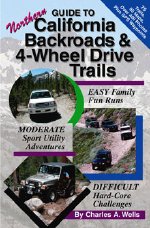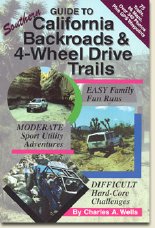Offroad and Backroad Books for Northern California, Part 4
Books reviewed: Guide to Northern California Backroads and 4-Wheel Drive Trails, and Guide to Southern California Backroads and 4-Wheel Drive Trails
When I want to look up trail information for a possible trip, I usually pull three books off of my shelf that cover the area in question. Two of those books will be from the Backcountry Adventures and Byways series of books. The third book will be one of these two Guides by Charles A. Wells.
Of those three series of books, this one is my least favorite, but that’s strictly relative. These books are still quite informative and will definitely be assets in your collection.
Physically, these books are close in size to Tony Huegel’s Byways series, although they’re a bit larger at 5.8 x 8.8″. Each of the books (and the out-of-state Arizona book as well) lists 75 trails. They retail for twenty-five bucks each, but as I write this the discounted price from Amazon is $16.49 apiece. Like some of the Byways series, these books can be had either in the standard binding, or as spiral bound, but the latter option is only available directly from the publisher.
Like the Backcountry books, the definition of northern and southern California is quite arbritrary. Where Backcountry has southern California extending far north of where I usually think of it, the Guide series does the opposite. Here, southern California begins far south of where most people would think: around Santa Barbara on the west, and Death Valley to the east. The North book dips quite far south in places, as far as N 32º at Oceano Dunes. There’s nothing wrong with either way of doing it, but when you’re looking to purchase these books it’s helpful to know whether or not a given book is going to cover the area you expect it to.
Like the two previously-reviewed series of trail books, each of these books starts off with an introductory chapter, which is invariably seventeen pages long. Mr. Wells is nothing if not consistent from book to book. We then get into the meat of these books – the trails – before wrapping up at the end with some basic GPS information, waypoints, a short glossary, reference and contact information, and an index.
Like the Byways series, these books are printed in black and white (the Backroads series has color maps and photos). Unlike the Byways series, however, there are several photos for each trail. Many of these are quite small, but they still give you a good idea of what any given trail is like.
The trail maps are similar to the Byways maps, although they are somewhat more detailed, including an underlying scale grid. This is a mixed blessing, offering additional information but also providing a more cluttered view of the trails.
Again, each trail is described by location, length and duration, difficulty and scenic ratings, etc. Historical and other points of interest are given, and it’s always interesting to see how these vary from book to book.
When it comes to the trails chosen for each book, this series varies from the other two in some key ways. First, there are more trails here that are rated as Difficult, which are challenging trails often requiring custom rigs. You’ll find trails like the Rubicon, Fordyce and Hell Hole in the Northern book, and trails like the notorious Sledgehammer in the Southern book. It’s nice to have these listed, although if you own a stock vehicle then there are going to be a lot of trails listed in these books that you won’t be able to use. In the Northern book, almost a third of the trails are rated as Difficult.
The second difference is that unlike the other books, this series lists a few offroad parks, like Hollister Hills SVRA, the BLM’s Cow Mountain area, and one route through the Clear Creek area. These are great to have, although there are many more areas that are not listed. I don’t expect any book to cover every trail in its area, so I guess it’s fair to expect the same from these listings as well.
For me, the trail directions in this book are by far the most difficult to follow. There’s a lot of information stuffed into a very small space, sometimes using abbreviations. Rather than presenting these directions in a step by step format (as in the Backcountry series where each direction has its own line), typically these directions are in one large paragraph. At your desk – but especially on the trail – you’ll be forever trying to find you place again. While the Byways series does the same thing, I feel that series does a better job of making their directions easy to follow. This is probably a subjective thing, so your mileage may vary.
The GPS coordinates, instead of being included with the directions as in the Backcountry series, are instead footnoted and included in the back of the book. That’s not ideal. The coordinates are given in Lat/Lon format (with minutes including one decimal place, so “35 32 22.7” and also in UTM. I’d use the UTM format which allows for much more precision, but the author makes clear that for each waypoint, an error of up to twenty meters may be involved. Fortunately, that’s well within the practical accuracy that we’ll need on the trails.
The tone of the writing in this series is a little different too. In the GPS Basics appendix (which also covers maps), we find the question “What specific equipment and maps do you use, Mr. Wells?” which seems a little contrived. And perhaps I’m reading too much into it, but to me it suggests that the author would prefer that that we address him as Mr. Wells. In one of the trail descriptions, where old structures and such are detailed, we are twice told “Don’t touch anything.” I guess there are times in this book where I felt like I was being addressed by a schoolteacher or parent instead of an easy-going guide.
I have another nitpick: sometimes we are told about beautiful locations, but other times not. “Great” and “gorgeous” views are described along the Copper Mountain trail (both are certainly true) but the Signal Peak trail description never mentions the spectacular and vast views you’ll have from that peak.
Clearly, there are several aspects to these books that make them less appealing to me than the Backcountry and Byways series, but these are all subjective. and not serious shortcomings. There is a lot of helpful information, and a lot of trails across California are covered. When combined with the other reference books in my library, I especially appreciate the trails and locations that aren’t covered elsewhere. These may not have won out as my favorite trail books, but I’m very happy to have them.

